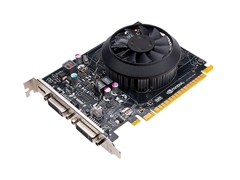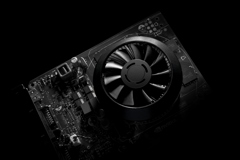
NVIDIA ha annunciato le prime video card basate su una gpu che implementa la nuova architettura Maxwell, il chip grafico a 28nm siglato GM107. Si tratta pi¨ in dettaglio di due modelli, denominati GeForce GTX 750 Ti e GeForce GTX 750, che il maker ha collocato nella nuova linea di schede video GeForce GTX 750.
Attraverso il comunicato stampa, che vi proponiamo di seguito in lingua integrale, NVIDIA chiarisce il punto di forza di entrambe le SKU GeForce GTX 750: queste card, infatti, puntano a offrire buone prestazioni nell'ambito del gaming a 1080p a fronte di un design che ne esalta l'efficienza dal punto di vista energetico.
A titolo di esempio, NVIDIA osserva che la GeForce GTX 750 Ti garantisce prestazioni molto vicine a quelle della GeForce GTX 480, una soluzione che, nel 2010, ha svolto il ruolo di flag-ship tra i prodotti basati sull'architettura Fermi, nonostante il suo consumo di potenza sia pari a 60W e dunque pari al 25% di quello della GTX 480.
Una tale efficienza dal punto di vista energetico ha permesso ai progettisti di non ricorrere a un connettore aggiuntivo per l'assorbimento della potenza elettrica dalla PSU: ne consegue che le schede video GeForce GTX 750 e GeForce GTX 750 Ti sono alimentate esclusivamente dal bus PCI-Express.
La gpu della GeForce GTX 750 Ti include 640 CUDA core, 48 TMU e 16 ROP; inoltre il suo core grafico lavora a 1020MHz (frequenza di clock di base) e fino a 1085MHz (frequenza di clock di boost), e scambia dati con il frame buffer, implementato a sua volta con 1GB o 2GB di RAM G-DDR5 la cui velocitÓ effettiva Ŕ pari a 5.4Gbps, attraverso un bus a 128-bit.
La gpu della GeForce GTX 750 integra invece 512 CUDA core, 40 TMU e 16 ROP; il core grafico lavora a 1020MHz (clock di base) e fino a 1085MHz (clock di boost), e scambia dati con il frame buffer, implementato con 1GB di RAM G-DDR5 @ 5Gbps, attraverso un bus a 128-bit.
Numerosi partner di NVIDIA, come ASUS, Colorful, EVGA, Gainward, Galaxy, Gigabyte, Innovision 3D, MSI, Palit, PNY e Zotac, hanno lanciato le video card GeForce GTX 750 Ti e GeForce GTX 750. Il prezzo indicato da NVIDIA per la GTX 750 Ŕ pari a $119, mentre quello della GTX 750 Ti Ŕ pari a $139 per la variante con 1GB di RAM e a $149 per quella con 2GB di RAM.

[Immagine ad alta risoluzione]

[Immagine ad alta risoluzione]

SANTA CLARA, CA - NVIDIA today introduced the first GPUs based on its new Maxwell graphics architecture, which deliver amazing gaming performance in extremely power-efficient designs.
The new NVIDIA GeForce GTX 750 Ti and GTX 750 GPUs showcase the ability of this first-generation Maxwell architecture to do more with less.
A GeForce GTX 750 Ti running at 1080p resolution doubles the performance and uses half the power of the GTX 550 Ti, which was built with the Fermi architecture, and is one of the most used NVIDIA GPUs, according to the Steam Hardware Survey.
The GTX 750 Ti also approximates the performance of the GeForce GTX 480 -- a $499 flagship product also based on the Fermi architecture -- while consuming only one-fourth the power, or 60 watts.
"We know that to advance performance, we must advance performance per watt, because every system we design for has a power limit -- from supercomputers to PCs to smartphones," said Scott Herkelman, general manager of the GeForce business unit at NVIDIA. "That's why we architected Maxwell to be the most efficient GPU architecture ever built."
The GTX 750 Ti GPU's small physical design -- at only 5.7-inches long -- doesn't require an internal power connector. Thus, gamers with PCs equipped with integrated graphics or other small form-factor designs can switch over for a great gaming experience at 1080p, without needing to upgrade their power supply or deal with increased energy costs.
Because the GTX 750 Ti consumes so little power, it runs extremely quietly and generates very little heat, making it perfect for use in home theater PCs, as well.
The GTX 750 Ti and 750 GPUs also include support for NVIDIA's breakthrough GameWorks program and unique gaming technologies, including:
- ShadowPlay, which lets gamers capture and share their gaming experiences on Twitch and other online sites,
- G-SYNC(1) display technology, for smooth, stutter-free gaming visuals, and
- GameStream, which allows gamers to stream their favorite PC games to NVIDIA SHIELD for high-performance gaming on the go.
"NVIDIA understands that delivering a next-gen gaming experience means a lot more than cranking up the clocks, heat and noise just to eke out a few extra frames per second," said Tony Tamasi, senior vice president of content and technology at NVIDIA. "Our GameWorks technologies, combined with the performance, power efficiency and cool and quiet operation of the GTX 750 Ti and 750, dramatically change the way gamers can play."
Availability and Pricing
The NVIDIA GeForce GTX 750 Ti and GTX 750 GPUs are now available from the world's leading add-in card suppliers, including ASUS, Colorful, EVGA, Gainward, Galaxy, Gigabyte, Innovision 3D, MSI, Palit, PNY and Zotac. Partner participation will vary by region. Pricing is expected to start at $119 for the GTX 750, $139 for the 1GB GTX 750 Ti and $149 for the 2GB GTX 750 Ti.
The GeForce GTX 750 Ti and GTX 750 GPUs will also be sold in fully configured systems from leading U.S.-based system builders, including AVADirect, Cyberpower, Digital Storm, Falcon Northwest, Geekbox, IBUYPOWER, Maingear, Origin PC, Puget Systems, V3 Gaming and Velocity Micro, as well as other system integrators outside North America.
News Source: NVIDIA Press Release
Links
|